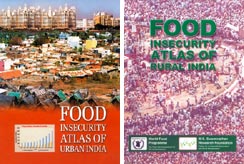
Hunger statistics
FOOD INSECURITY ATLAS OF RURAL INDIA . FOOD INSECURITY ATLAS OF URBAN INDIA . M S Swaminathan Research Foundation . World Food Programme . 2001 and 2002 "Indian famines are famines of work, not of

FOOD INSECURITY ATLAS OF RURAL INDIA . FOOD INSECURITY ATLAS OF URBAN INDIA . M S Swaminathan Research Foundation . World Food Programme . 2001 and 2002 "Indian famines are famines of work, not of
Why are we, as a nation, so non serious about following through on actions? Is it the curse of a foreign language in which we act, but not think, that we pick up words and so believe the deed, too,
A typical Indian village shares a complex, yet fragile ecological equation with both private and common resources. Even a small disturbance can lead to poverty
<p>With relations between countries now being shaped by geo-economics rather than geo-politics, an emerging issue is to what extent the United States, China and India, all populous countries and top tier

GANDHI's Vision and Valuesis meant to be a serious exploration into the contemporary meaning of Hind Swaraj and the kind ofpossibility it indicates for agricultural practices in rural India. Hind
The Philippine government is compelled to take major steps to ease poverty and unemployment in the drought-stricken Southeast Asian region. The farm sector, which analysts say has been neglected by
Jeffrey M Smith has written about 65 scientists who have conducted tests on genetically modified organisms (GMOs) in his book Genetic Roulette. He talks about the impact and hazards of Bt gene. He spoke to Savvy Soumya Misra at the launch of his book in Delhi recently Safety: Lab tests on mice showed allergies, disruption in reproductive cycle, hormonal imbalance, respiratory

Biological issues took precedence over all others at the recently held science congress in Chennai

Martha Wangari Karua is a cabinet minister for water resource management and development in Kenya. A lawyer by profession, she is among that rare breed of no nonsense politicians fighting to provide water for all in her water scarce country. In an exclusi

The land of white elephants has been named among one of the four honoured Asian countries which have managed to achieve self-sufficiency in food for growing and increasingly affluent populations.
A plan of Rs 25,000 crore for Maharashtra for the year 2008-09 was on Wednesday approved by the Planning Commission at a meeting in New Delhi. The approval was given during today's meeting of Chief Minister Vilasrao Deshmukh with Planning Commission deputy chairman Dr M S Ahluwalia. This year's plan is Rs 4,800 crore higher than the previous year, an official release said here. The Planning Commission expressed satisfaction over the performance shown by the state government in various sectors and the formation of the minority welfare department in the state. The chief minister had demanded allocation of Rs 210 crore for Youth Commonwealth Games scheduled to be held in October at Pune. He had also demanded Rs 400 crore for the Mithi river beautification project. Complimenting the State on satisfactory growth rate and fiscal performance, Ahluwalia said Maharashtra was poised to exceed the projected national average growth rate of nine per cent for the 11th Plan (2007-12). He, however, stressed the need to improve urban infrastructure, irrigation and agriculture during the Plan. He further said the Centre was keen to improve connectivity with Mumbai. Also, the Western Freight Corridor Construction Work was likely to begin this year. He also drew the attention of the state towards depleting forest cover, rural poverty and child sex ratio. It was pointed out that state needed to step up efforts in the power sector for encouraging investment.
Chidambaram may try to shift attention from high prices of essentials If everybody, including political parties, is talking about farmers it must be election time. Close to election, it has become more or less a trend for the government of the day to announce sops for the agriculture and rural sectors in its budget proposals. So even while the common man has to swallow the bitter pill of the "inevitable' petrol and diesel hike before the 2008-09 budget, there is a promise of a "populist budget' for farmers and the aam garib aadmi this year. Low growth rate With several States going to the polls this year ahead of the next year's Lok Sabha election, there may be an attempt to shift the attention from the high prices of essential commodities, low growth rate (2.3 per cent in the 10th Plan) in agriculture, the disconnect between a high Gross Domestic Product and the rural sector, with problems of displacement, migration, unemployment, suicides by farmers and impending food crisis. This budget is most likely to convey the last ditch attempt of the Congress-led United Progressive Alliance (UPA) government to redeem itself from the scars caused in the countryside by farmer suicides and dispossession of rural families on account of Special Economic Zones and other industrialisation projects. Without doubt, the Debt Relief Package for Institutional Loanee Farmers (as reported first in The Hindu) and the expansion of the National Rural Employment Guarantee Act (NREGA) Programme will be at the centre of Finance Minister P. Chidambaram's budget proposals. Fertilizer policy Besides, it is expected that he will unveil a rationalised fertilizer policy to encourage balanced use of fertilizers, especially muriates, to revive farm soil. Some succour is also essential for the wives of indebted farmers who committed suicide. There is a growing demand to strengthen the National Agriculture Insurance Scheme (NAIS) and to have a Health Insurance Scheme for farm households, as various surveys showed that most the credits in the informal sector were not only farming related but also to meet the requirements of health, celebrations and even life-style. From all accounts, the pilot weather-based crop insurance may be expanded. Fund requirements It is estimated that the total fund requirement for the expansion of the NREGA from the present 330 districts to 600-odd will be about Rs. 16,000 crore. On the other hand, the debt relief, covering an estimated 35 per cent farmers who had availed themselves of bank loans, is estimated at Rs. 40,000 crore in the first year. The Union government will pay off the dues to banks. A Price Stabilisation Fund is also proposed to be set up with contributions from the government, banks and farmers. Well-placed sources hinted that the Finance Minister may cull out unspent funds from social sectors such as rural development, education and health to partially meet the requirement of the Farmers' Debt Relief Package. It is anybody's guess if the Minister will reduce the interest rate on farm loans from the current 7 to 4 per cent as recommended by the National Commission on Farmers. There is also a demand to raise the credit limit under the Kisan Credit Card scheme. There is an expectation that enhanced budgetary support will continue for the flagship rural programmes, including the swarozgar yojana (self-self groups), Pradhan Mantri Gram Sadak Yojana, Indira Awas Yojana and the Drinking Water Supply programme. The highest increase, however, is expected in the Land Resources Programme under the Integrated Wasteland Management Programme. In the agriculture sector, allocation has to be enhanced for the Rashtriya Krishi Vikas Yojana to enhance production and productivity and to the National Food Security Mission to increase the output of rice, wheat and pulses. Both schemes are new and yet to take off. Irrigation schemes, horticulture mission and agriculture research will get the customary support, as growth in farm "allied sectors' comes from these areas. The National Rainfed Area Authority is most certainly likely to get financial support. Food subsidy The food subsidy bill is likely to cross the Rs 30,000 crore-mark. This is due to the wide difference between the minimum support prices (MSP) paid to farmers and the central issue price of grains sold through the Public Distribution System, as well as on account of the food grains import bill. The subsidy bill to go up further as the food grain stocks are expected to dwindle by April 1, possibly resulting in more imports. With apprehensions of an avian influenza pandemic, a comprehensive rehabilitation package for the poultry industry and bird flu-affected farmers, as part of a Bio-Security Policy, will be announced in the budget, if not earlier. However, the package may include only such poultry farmers, who get linked to institutional poultry farms and the industry. It remains to be seen how the government's packages will play out for the thousands of those in the informal sector who do not have the income and the collateral to avail themselves of institutional loans. Funds utilisation It is expected that in this last year of the UPA government's regime, the emphasis will be on consolidation, with focus on better implementation, monitoring and utilisation of funds. In particular, the Congress has shown signs of being zealous of taking credit for the central funds made available to States, to reap a harvest during election time. The biggest challenge, however, is making agriculture viable for the 82 per cent small and marginal farmers and bailing them out of the clutches of the informal system of borrowing.

The new US foreign policy on environment, if well implemented, should shake African nations out of a long stupor into tackling massive eco degradation in the continent

Shenghui Wang, an economist with the World Bank and one of the authors of the study on Bt cotton in China, on the future of the technology in India and China

Medicinal plants can improve the fortunes of state's rural poor
A major programme of beekeeping and sericulture has been launched by the International Centre of Insect Physiology and Ecology (ICIPE) in Kenya. The project, it hopes, will alleviate rural

As the Himalayan country s forestry scheme for the poor reaps rich dividends, its government entrusts more degraded areas to the underprivileged. The only hurdle for a complete environmental revival seems to be bureaucratic inertia
The country's remote north-western province could serve as a model for Africa's poverty-ridden, famine-stricken areas. The province has been transformed from a food-deficit to a food-surplus
<p>Nepal has achieved a new milestone in conservation by achieving ‘zero poaching’ of rhinos, tigers and elephants for the year period ending in February 2014, according to the World Wildlife Fund Nepal. Read more in this March 2014 edition of the Monthly Overview on State of Environment, Nepal.</p>

"CARRYING capacity" is likely to be the Catchphrase of the Year. The term is liberally sprinkled throughout State of the World Report 1994, like some sort of mantra. To illustrate "a breach of